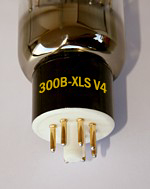EML 300B-XLS, EML 300B-XLS V4. Data Sheet
Description
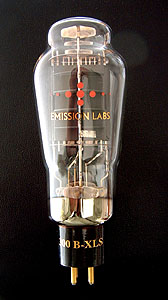 |
This tube has the classical grid construction and the tube curves of the 300B. It has the stronger Anode construction and larger glass of the vintage 52B however. So in one tube we have combined the very best of two classical products.
|
Guarantee program for first owner.
The first owner can register the tube within 4 weeks after receival, at the Emission Labs website, to participate in the 5 years guarantee program, which is additional to the legal obligations of the seller.
Register here for the 5years guarantee
Features
- Gold Plated Grid(Note8)
 Soft rubber suspended tube base
Soft rubber suspended tube base- Hard metal Construction(Note1)
- Extra large getters
- Hand blown Glass bulb
- Anti-microphonic Anode- and grid suspension
- These tubes are shipped in a high quality dual box
- Tube printing with 24k gold, and red color burned into the glass
- YAMAMOTO tube sockets highly recommended.
- Gold Plated, black ceramic socket
Sound Character of the EML 300B-XLS
For use in Single Ended amplifiers, the 300B-XLS is an ideal choice, because with those amplifiers good sound results from the right use of the tube, not over stressing the tube. This means the tube should not be working at the maximum electrical limits. Here we think the 300B-XLS is at it's right place, taking advantage of the higher electrical reserve this tube has. The 300B-XLS will reproduce the required loudness with more ease than the standard 300B. The result is a more transparent sound picture at low or medium volume, while at higher volume, the dynamics of the original recording will stay unaffected.
For use in Push Pull amplifiers, this tube is also an excellent choice, because this type of amplifier is hard on the tubes by definition. The 300B-XLS is made to deal with such conditions, and will allow the amplifier to play gently at low sound level, as well as reproduce higher sound level with the detail and precision you expect from a push pull amplifier.
Bias of the 300B-XLS
The 300B-XLS will bias in any amplifier the same way as the original WE300B. Sill it can be used in two ways if you want it. These two methods are explained here.
- It is possible to replace any 300B with this tube. Just plug it into any 300B amplifier, and the tube will set itself exactly to the original 300B working point. The EML 300B-XLS is a very strong tube,and it will develop the output power with more ease. Specially for amplifiers that let the 300B tubes work very hard, the EML 300B-XLS is the right product choose. Any amplifier that is trying to get as much as possible power out of a normal 300B, will benefit from the 300B-XLS. Improved sound and longer lifetime will be the result.
- Another purpose of the EML 300B-XLS is to get more power,as would be possible with standard 300B tubes. This can only be done when there is the possibility to adjust the bias of the amplifier higher. If the Anode current of the tube is set ABOVE the standard 300B specifications, the tube will now move to a part of the curves with lower Anode resistance. This is a specialty of the 300B-XLS. This will give a better damping factor of the bass loudspeakers, resulting not in more bass, but in a more natural sound. Check our customer feedback section of the website!
- Alternatively the whole amplifier can be constructed around the 300B-XLS, of not only the anode current is increased, but also the supply voltage. A list of recommending working points is given, further down in this data sheet.
All critical parts, like filaments, grids and Anodes are constructed of hard metal for the best reliability and reproducible quality.
We have two versions for the heater:
Normal heater with the UX4 Socket, or Cathode Tapped heater with an octal socket. Tubes with the Cathode Tapped heater have an additional electrical connection, and need an octal socket for this reason. The Cathode Tap, provides a REAL electrical cathode, which simplifies schematics, improves signal to noise ratio, increases tube output power and lowers distortion. Yet, if desired afterwards, these can always be used as regular 300B-XLS, by simply not connecting the Cathode Tap.
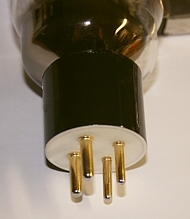
Normal UX4 Socket
Here is a link to Application Note 06, describing the Cathode Tapped tubes in general.
EML-300B-XLS Filament Ratings (See note 5) |
||
Standard tube 300B-XLS 4Pin Socket (UX4) |
Cathode Tapped 300B-XLS V4 8Pin Socket (Octal) |
|
| Filament Voltage (AC or DC) | = 5 Volt |
|
| Tolerance on filament voltage | ||
| Filament Current | ~ 1.5Amp |
|
EML-300B-XLS Factory Test conditions |
|
| Anode Voltage | |
| Anode Current | |
EML-300B-XLS Factory Test Result at 495V, 100mA |
|
| Grid voltage ( DC heated) | |
| Transconductance | |
| Note: these are average values, variation is appr 5% for random tubes. Any other current will also give another transconductance | |
EML-300B-XLS incoming inspection. Tested at 495V, 100mAMultiply -Grid Voltage with transconduction |
|
| New tube | |
EML 300B-XLS Maximum Ratings |
|
| Maximum Anode Voltage | 600V |
| Maximum Anode Dissipation | 55Watt |
| Peak Anode Dissipation | 60Watt |
| Maximum Anode Current Fixed Bias |
110mA |
| Maximum Anode Current Auto Bias |
120mA |
| Recommended grid Resistor | 100k Auto Bias |
| Maximum grid resistor Auto Bias | 150k Auto Bias |
300B-XLS Recommended Single Ended operating points
| |||||||||
Anode Voltage | Control Grid Voltage |
Anode Current (mA) |
Cathode Bias Resistor |
Anode Rp (Ohm) |
Gain |
Load (Ohm) |
Anode Dissi-pation |
Power Output (Watt) |
2nd harm. (dB) |
400 |
-74 |
60 |
None |
720 |
3.8 |
3500 |
24 |
11 |
27 |
400 |
-74 |
80 |
None |
720 |
3.6 |
2500 |
32 |
13 |
26 |
Lifetime is very high: | |||||||||
450 |
-100 |
60 |
None |
780 |
5.2 |
4000 |
27 |
13 |
26 |
450 |
-100 |
60 |
None |
780 |
5.3 |
5500 |
27 |
10 |
31 |
Lifetime is very high: |
|||||||||
450 |
-98 |
73 |
None |
720 |
4.1 |
2000 |
33 |
16 |
22 |
450 |
-98 |
73 |
None |
720 |
4.5 |
3000 |
33 |
13 |
26 |
450 |
-98 |
73 |
None |
720 |
4.9 |
4500 |
33 |
11 |
31 |
Lifetime is very high: |
|||||||||
450 |
-97 |
80 |
None |
700 |
4.2 |
2000 |
36 |
18 |
22 |
450 |
-97 |
80 |
None |
700 |
4.6 |
3000 |
36 |
15 |
26 |
450 |
-97 |
80 |
None |
700 |
4.9 |
4500 |
36 |
12 |
31 |
Lifetime is high: |
|||||||||
475 |
-97 |
90 |
None |
670 |
4.7 |
1900 |
43 |
21 |
23 |
475 |
-97 |
90 |
None |
670 |
5.1 |
2800 |
43 |
17 |
27 |
475
|
-97 |
90 |
None |
670 |
5.5 |
4200 |
43 |
14 |
32 |
Lifetime is good: |
|||||||||
500 |
-98 |
110 |
None |
630 |
5.4 |
1800 |
55 |
27 |
23 |
500 |
-98 |
110 |
None |
630 |
5.9 |
2700 |
55 |
22 |
27 |
500
|
-98 |
110 |
None |
630 |
6.3 |
4000 |
55 |
17 |
32 |
The above are high power working points. Hand adjustable, no auto bias. Design such amplifiers with care.
|
|||||||||
Choice of output transformer impedance: For each working point, a wide range of primary impedance is possible. When using a transformer of another value, you can estimate the output power and distortion by averaging between two rows of this table. Example: 500V, 110mA. Use of Lundahl LL1623-120mA (3k type). This will give you appr. 20 Watt @ 28dB 2nd harmonics. (28dB distance of signal to 2nd harmonics. |
|||||||||
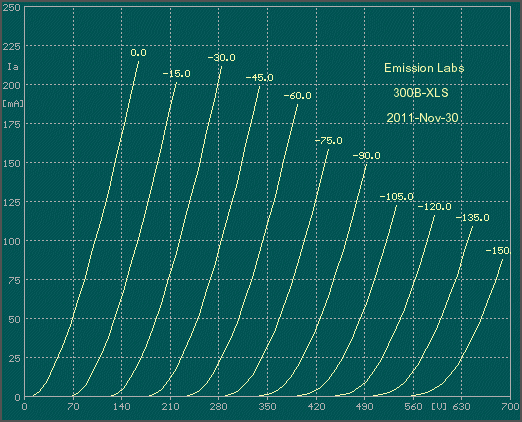
EML 300B-XLS tube curves. See Note 3
300B-XLS Curves as white Print Version
Some recommended Lundahl transformers |
|||
| Primary |
Secondary |
Anode Current | |
| LL1623-090mA 11Hz @1.5dB |
3000Ω | Alt.B = 4Ω Alt.C = 8Ω Alt.D = 16Ω |
90mA |
| 3000Ω | Alt.B = 4Ω Alt.C = 8Ω Alt.D = 16Ω |
120mA | |
| Alternative: Use transformer Impedance Boards for LL1623 by JACMUSIC. EE16 switches between 4 and 8Ohms at 3k. EE18 switches between 8 and 16Ohms at 3k. |
|||
| 3000Ω | 8Ω | 80mA | |
Complete list of recommendations here |
|||
300B-XLS Mechanical Data
|
|
 Standard UX4 Base |
Pin 1: Heater1 |
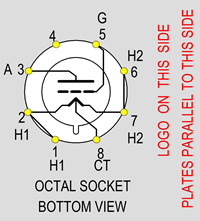 Special Octal Base, V4 Version |
Pin 1+2: Heater1 |
Notes
- Hard-metals can be used in electron tubes, though these are more difficult to use, and more costly than classic nickel. Hard metal Anodes have a more precise Anode distance, and do not change shape when heated, or at mechanical shock. This ensures reproducible tube parameters, and long term stability. Wolfram grids allow the most precise grid wire distance, because wolfram is an extreme hard metal. Best grid geometry ensures uniformity and linearity of the tube curves.
- Individual Test data, such as: Matching Data, Grid Current, Vacuum, Filament Current, etc., are on the Certificate that is on the outside of the tube box. Each tube is numbered from the inside, with a metal Tag
- Average Plate Characteristics are made with the Sofia Digital Curve tracer.
- The Western Electric 1950 Data sheet. says 36 Watt maximum dissipation. Later data sheets say 40 Watt. Though 40 Watt is possible, this is a peak value only, and no normal working point. When you intent to get the 'maximum' out of a 300B, and operate this tube at the limits of safe operation, it is a better idea to use the 300B-XLS in such a case.
- Some of our competitors claims to be the only one with a Center Tapped filament, but at EML we build since many years all tubes Cathode Tapped, not just this tube.
- Do not experiment with lower filament voltage, to expect better lifetime. We already specify filament voltage for the best lifetime.
- Gold Plated grids have a few advantages, such as increased bias stability, some protection against accidental overload, and better linearity of tube curves.
- The curves for the 300B-XLS are plotted, with DC heating.
- Heater voltage is always defined at the tubes pins itself. There may be some voltage drop along the wires, and tube contacts as well. So voltage measured at the tube socket wiring should ideally be 5.1V.
